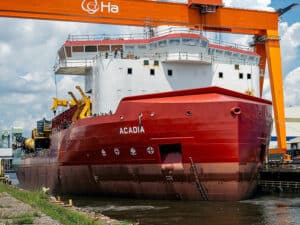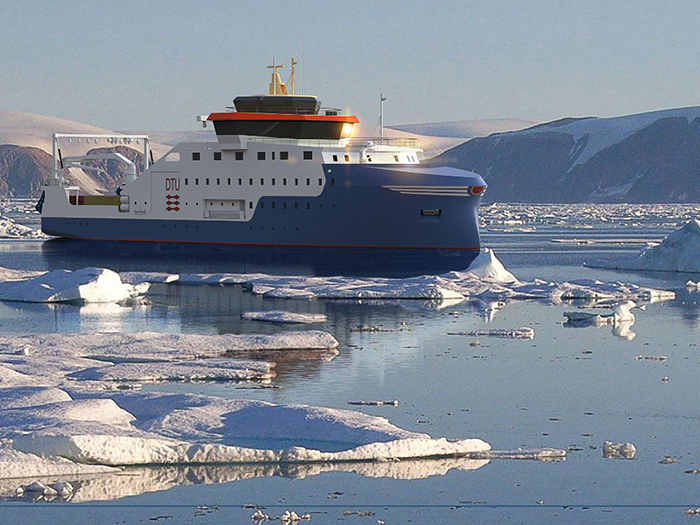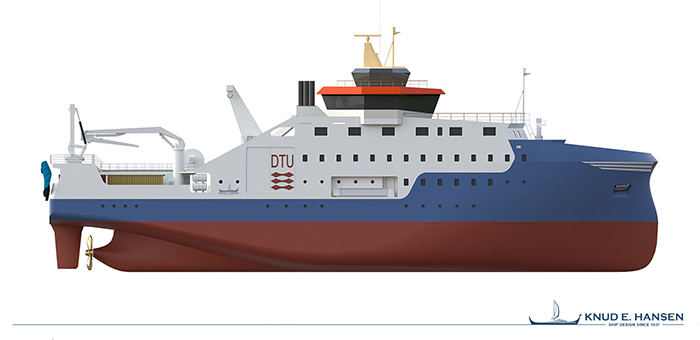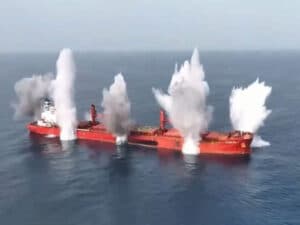
DTU plans replacement research vessel
Written by Nick Blenkey
Image courtesy Knud E. Hansen
Denmark’s National Institute of Aquatic Resources, DTU Aqua, urgently needs to replace its aging research vessel R/V Dana IV. The ship will face its 40 year class survey at the end of 2022.
DTU Aqua and naval architect firm Knud E. Hansen have now completed a comprehensive design study for a new 65 meter multidisciplinary marine research vessel.
The purpose was to develop a concept design and budgetary cost estimate for a for a highly advanced multidisciplinary research vessel that would position DTU Aqua as an attractive partner for international scientific projects.
The resulting concept design is optimized for cost-effective fish stock assessment, hydro-acoustic studies and biological, chemical and physical oceanography.
The following objectives were prioritized:
- Maximum capacity for hydro acoustic scientific performance
- High efficiency in fish stock monitoring
- High scientific multidisciplinary performance through versatile design
- Year-round operation in North Sea and Baltics
- Summer/ Autumn operation in Greenland and Polar waters
- Low operational costs
The vessel is designed for class notation DNVGL ✠ 1A, SPS, EO, DYNPOS (AUTS), PC (6), and to comply with the ICES CRR 209 standard for low underwater radiated noise (URN) emission.
The DTU Aqua operating area will primarily be the Baltic Sea, the Gulf of Bothnia, the Kattegat, the Skagerrak, the North Sea, the North Atlantic and Greenlandic waters in summer and autumn. The vessel is designed to operate world-wide including the geographical coverage area of the IMO Polar Code up to approx. 80° N, depending on the ice situation.
The capacity of the vessel includes single and double cabins for 34 crew and personnel of whom an average of 18-20 are expected to be researchers.
The vessel is arranged with a full suite of hydro-acoustic transducers, multiple laboratories trawl gear, cranes, CTD and deck equipment to support multi-disciplinary research operations. The CTD cranes can operate and sample water to depths of 3,000 meters as well as handling underwater equipment ranging from small plankton nets and bottom corers and towing of multinets.
The trawl gear is arranged for flexible and efficient operation with multiple net drums and flush deck hatches to two receiving bins. Laboratories are arranged adjacent to CTD Hangar, and below trawldeck to allow efficient handling of fish samples and a variety of wet or dry laboratory work to be carried out simultaneously.
The acoustic transducer suite can carry out a full range of hydro-acoustic surveys, such as bottom mapping, sub-bottom profiling, current profiling, 3D visualization of fish stocks and biomass estimation.
The multifunction deck is equipped with a bolt grid for flexible arrangement of research gear combined with up to four (4) ISO 20′ containers. The side bulwark for the trawl lane, as well as the transom bulwark aft and the starboard side can be removed, so that the overall multi-deck area can be expanded to include the trawl lane.
The building cost of the vessel have been estimated in consultation with several shipyards within continental Europe.
The design study concludes that it is possible for DTU Aqua to have the 65-m ice classed multidisciplinary marine research vessel designed, built and commissioned within a total budget of about $52 million.





